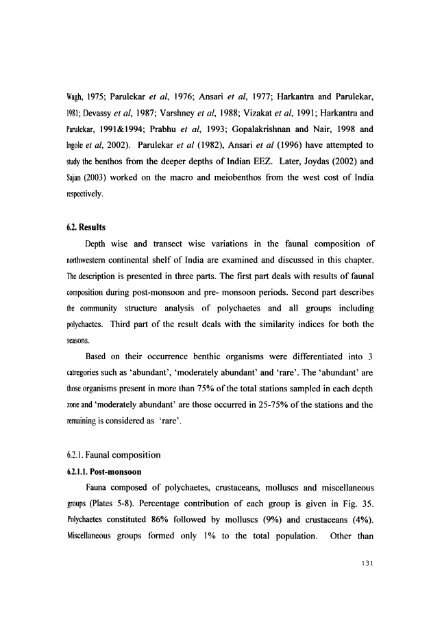L - Cochin University of Science and Technology
L - Cochin University of Science and Technology
L - Cochin University of Science and Technology
Create successful ePaper yourself
Turn your PDF publications into a flip-book with our unique Google optimized e-Paper software.
Wagh, 1975; Parulekar et ai, 1976; Ansari et ai, 1977; Harkantra <strong>and</strong> Parulekar,<br />
1981; Devassy et ai, 1987; Varshney et ai, 1988; Vizakat et ai, 1991; Harkantra <strong>and</strong><br />
Parulekar, 1991 & 1994; Prabhu et ai, 1993; Gopalakrishnan <strong>and</strong> Nair, 1998 <strong>and</strong><br />
Ingole et ai, 2002). Parulekar et al (1982), Ansari et al (1996) have attempted to<br />
study the benthos from the deeper depths <strong>of</strong> Indian EEZ. Later, Joydas (2002) <strong>and</strong><br />
Sajan (2003) worked on the macro <strong>and</strong> meiobenthos from the west cost <strong>of</strong> India<br />
respectively.<br />
6.2. Results<br />
Depth wise <strong>and</strong> transect wise variations m the faunal composition <strong>of</strong><br />
northwestern continental shelf <strong>of</strong> India are examined <strong>and</strong> discussed in this chapter.<br />
The description is presented in three parts. The first part deals with results <strong>of</strong> faunal<br />
composition during post-monsoon <strong>and</strong> pre- monsoon periods. Second part describes<br />
the community structure analysis <strong>of</strong> polychaetes <strong>and</strong> all groups including<br />
polychaetes. Third part <strong>of</strong> the result deals with the similarity indices for both the<br />
seasons.<br />
Based on their occurrence benthic organIsms were differentiated into 3<br />
catregories such as 'abundant', 'moderately abundant' <strong>and</strong> 'rare'. The 'abundant' are<br />
those organisms present in more than 75% <strong>of</strong> the total stations sampled in each depth<br />
zone <strong>and</strong> 'moderately abundant' are those occurred in 25-75% <strong>of</strong> the stations <strong>and</strong> the<br />
remaining is considered as 'rare'.<br />
6.2.1. Faunal composition<br />
6.2.1.1. Post-monsoon<br />
Fauna composed <strong>of</strong> polychaetes, crustaceans, molluscs <strong>and</strong> miscellaneous<br />
groups (Plates 5-8). Percentage contribution <strong>of</strong> each group is given in Fig. 35.<br />
Polychaetes constituted 86% followed by molluscs (9%) <strong>and</strong> crustaceans (4%).<br />
Miscellaneous groups formed only 1 % to the total population. Other than<br />
131

















